There's been a great deal of discussion about diffraction and higher order modes on diyaudio lately. In a nutshell, it appears that diffraction may be more offensive than harmonic distortion. At the very least, diffraction muddies the soundstage by creating unnatural soundstage cues.
I have personally experimented with a number of the treatments used by Dr Geddes to treat diffraction. I started a few years back by applying HOM-reducing foam to a set of tractrix horns, built a few oblate spheroidal waveguides, and purchased a set of Gedlee Summas.
Subjectively, I noticed that the better waveguides were less affected by the treatments that Geddes prescribes. For instance, the improvement of the foam was less audible with an OS waveguide than with a tractrix horn.
I was curious to investigate this further, so I took a pair of the craziest horns that I have, gave them a serious set of tweaks, then measured and listened.
I hope you find the results as enlightening as I did!
I have personally experimented with a number of the treatments used by Dr Geddes to treat diffraction. I started a few years back by applying HOM-reducing foam to a set of tractrix horns, built a few oblate spheroidal waveguides, and purchased a set of Gedlee Summas.
Subjectively, I noticed that the better waveguides were less affected by the treatments that Geddes prescribes. For instance, the improvement of the foam was less audible with an OS waveguide than with a tractrix horn.
I was curious to investigate this further, so I took a pair of the craziest horns that I have, gave them a serious set of tweaks, then measured and listened.
I hope you find the results as enlightening as I did!
Before we dig into this, I should define what a "HOM" is. According to Geddes:
"Higher Order Mode, its a term that I coined to define waves that propagate in a waveguide that do not go down the axis, but travel by bouncing off of the walls. They are not predicted by the Horn Equation, so most people didn't even know that they existed (I was the first person to hypothesize there existance). The Waveguide Theory predicts them, and low and behold, it turns out that they are quite significant to audibility. Minimizing them yields a far better sound quality. But with "horns" its not possible to minimize them because you don't know what to do - the equations aren't rigorous enough to predict them so they are simply ignored."
http://www.diyaudio.com/forums/showpost.php?p=1244962&postcount=106
"Higher Order Mode, its a term that I coined to define waves that propagate in a waveguide that do not go down the axis, but travel by bouncing off of the walls. They are not predicted by the Horn Equation, so most people didn't even know that they existed (I was the first person to hypothesize there existance). The Waveguide Theory predicts them, and low and behold, it turns out that they are quite significant to audibility. Minimizing them yields a far better sound quality. But with "horns" its not possible to minimize them because you don't know what to do - the equations aren't rigorous enough to predict them so they are simply ignored."
http://www.diyaudio.com/forums/showpost.php?p=1244962&postcount=106
Based on the definition from the previous post, if someone wanted to create gobs and GOBS of homs, here are a few ways to do it:
- Use a horn that has a diffraction throat. The diffraction slot improves the directivity of the horn, but at the expense of sound quality.
- Use a horn that is poorly terminated. For example, a horn that is poorly mated to the baffle.
- Even worse, use a horn that doesn't even have a baffle. That will create a ton of HOMs.
- HOMs are created when the wave bounces off the walls. Therefore, a horn with a mouth that isn't equidistant from the throat will have a lot of HOMs. In other words, a horn that doesn't have a round mouth.
- HOMs are cumulative, so if you really wanted to create a HOMster(tm), combine all of the previous things!
Ladies and gentlemen, I present the HOMster:
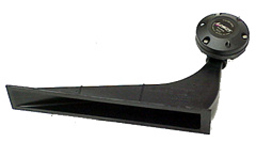
This is a horn that has a diffraction slot, partial termination, and a rectangular mouth.
Let's tweak this thing and see if we can make it better.
After looking at the pic above, a lot of you are probably wondering what the hell that thing is. It's a horn for a car. I bought a set a few years back. As I alluded in an earlier post, I noticed that the treatments espoused by Geddes seemed to work better on horns than on waveguides. My theory is that horns have a ton of HOMs, therefore the improvement is more audible.
I am not aware of a way to measure HOMs. Having said that, my Summas image like crazy, and I believe the treatments which reduce HOMs also improve imaging. Though I can't measure HOMs, I *can* measure on and off axis response.
So here's the question:
Will the tweaks improve the on and off axis response?
If there is mesurable improvement, it should correlate with an improved soundstage, since soundstaging is improved dramatically when the off-axis response is consistent with the on-axis response.
Let's find out...
I am not aware of a way to measure HOMs. Having said that, my Summas image like crazy, and I believe the treatments which reduce HOMs also improve imaging. Though I can't measure HOMs, I *can* measure on and off axis response.
So here's the question:
Will the tweaks improve the on and off axis response?
If there is mesurable improvement, it should correlate with an improved soundstage, since soundstaging is improved dramatically when the off-axis response is consistent with the on-axis response.
Let's find out...
A "Car Horn".
But where is the diffraction slot?
There's a vertical diffraction slot in the horn, about two inches forward of the throat. It appears to have a dramatic effect on the power response. The off-axis response is remarkably consistent considering the horn is dramatically asymmetrical.
Here's the frequency response of The HOMster, in my car, completely untreated. It was measured at 0, 15, 30 and 45 degrees with the microphone at ear level, and the HOMster mounted under the passenger side of the dash. In this mounting position the dash forms a baffle for the HOMster at the top, but it's basicall unbaffled on the bottom. IMHO the lack of a baffle will create tons of HOMs. Let's find out...
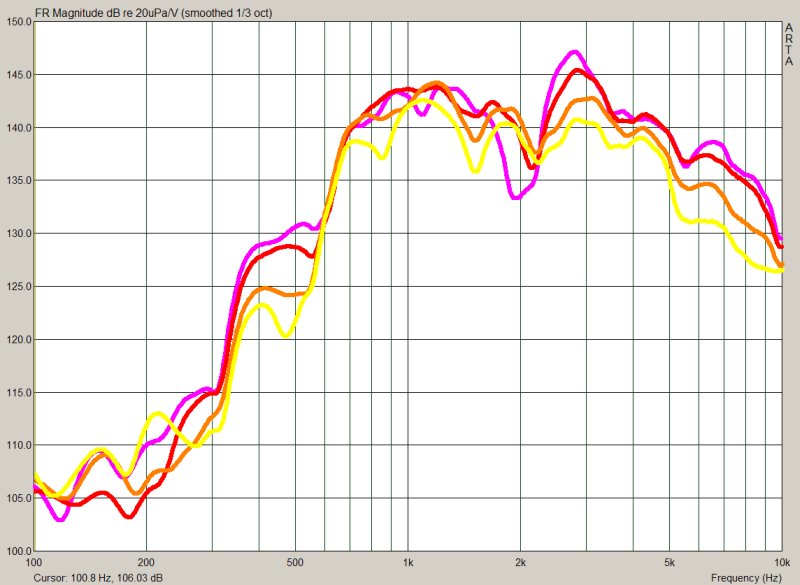
You could look at this two ways. The good news is that the horn will sound better off axis than on-axis. In a car, this is A Very Good thing. OTOH, the speakers that image the best have a consistent response on axis and off. That doesn't mean that the response must be the same level, but the curves should be consistent.
Can we improve this?
The use of a roundover on a speaker or a horn should improve the off axis response. The reason is that the sound from the radiator diffracts off the edges, creating secondary sound sources delayed in time. Those secondary sources muddy the image. Reflections can be a significant fraction of the energy, so their affect on soundstaging is dramatic. Because the effect is delayed in time, it also reduces intelligibility.
One of the things that I love about my Summas is their ability to retrieve details in the mix that are inaudible over conventional speakers. For instance, I'll listen to a track and note that there's a background singer that I'd never noticed before, and it's also a champ at differentiating various instruments in the mix.
Can a simple roundover bring some of this goodness to The HOMster?
To find out, I took a piece of 2" PVC pipe, cut it in half, and duct taped it to the *bottom* of The HOMster. I didn't bother with the top, since it's flush with the dash. I didn't bother with the left or right at this stage either.
Here's the measured response with and without treatment:
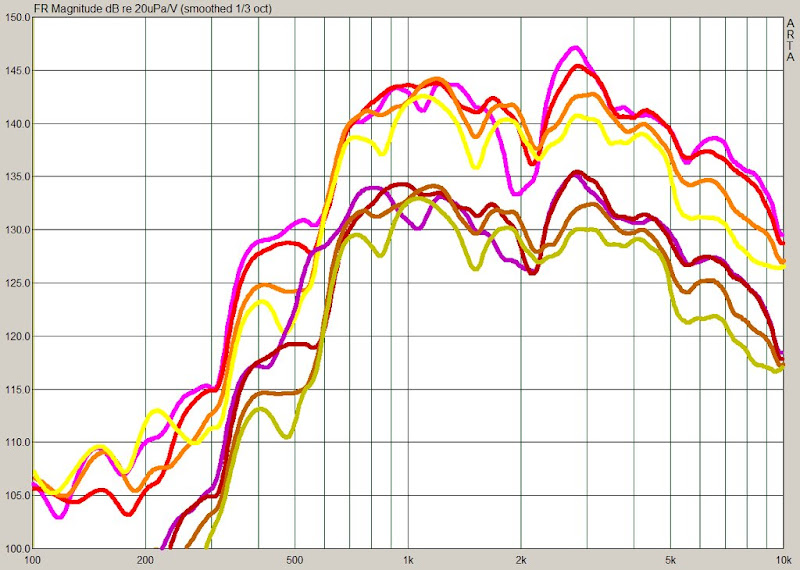
As above, the horn is measured at 0, 15, 30 and 45 degrees. Both measurements were performed at the same voltage level. In the graph I offset the second set of measurements by 10db. Ignore the SPL levels; I am too lazy to measure the voltage so I simply adjust the volume to generate a clean measurement.
So what do you think?
Here's what I notice:
- The on-axis notch at 2khz is wider and shallower.
- The peak at 2800hz is reduced by 3db
- After treatment, the 0 degree curve and the 15 degree curve match a lot better. (zero is purple, 15 is red.)
- The treated horn is more consistent on axis and off, particularly at 0 and 15 degrees.
- Though the 45 degree curve (yellow) isn't as good as the 30 degree curve (orange), it's better with the roundover than without.
IMHO, these are great results for a dollar worth of PVC and a bit of duct tape. I'd love to see someone try this with a conventional loudspeaker.
But I'll take it to the next level anyways... In the next step we'll tweak it further.
Are you also going to measure the directivity of the device?
If a device relies on diffraction to control its directivity, then maybe adding foam could affect its directivity.
I think the measurements in this thread demonstrate that a roundover and the Geddes foam improve the consistency of the on and off-axis response.
Objectively, this is A Good Thing, because a consistent response off axis improves the soundstaging of a loudspeaker.
I'll throw in some subjective commentary too...
The roundover on The HOMster really made an improvement. But what if we filled the horn with foam? And while we're at it, why don't we add a vertical roundover?
So I chopped up about fifty cents worth of PVC pipe, and added about a dollar worth of 30 ppi reticulated foam inside the horn.
Geddes uses reticulated foam to damp the sound which doesn't travel down the axis of the horn. The way that the foam works is that it absorbs the axial wave once, but the reflections inside the horn are absorbed many times. (Since the reflected energy is reflected back down the throat, off the walls, off the mouth, etc...)
Also, just to be a complete lunatic, I put a *full* roundover on the horn. In other words, the roundover extends *into* the mouth. Because the top of the horn is baffled, my hypothesis was that this wouldn't affect the low end dramatically. Besides, if half a pipe is better, how about a full pipe?
Here's what the horn looks like for these measurements:

Note the roundover on the sides *and* the mouth.
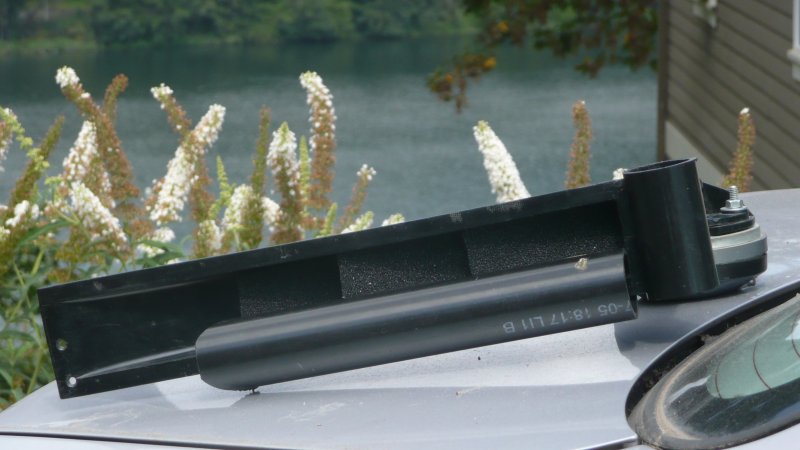
The horn has been filled with 30ppi reticulated foam. The 2" PVC pipe extends all the way into the mouth now. In the previous measurements, it was a half pipe, duct taped to the bottom of the horn.
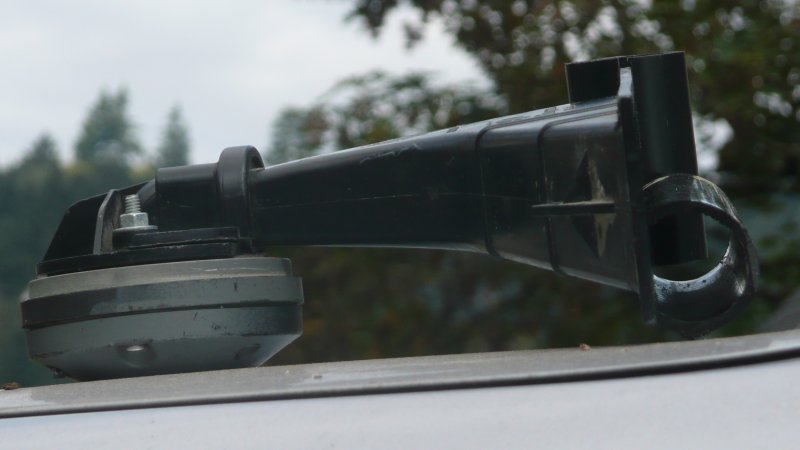
In the side view you can see this is a REALLY small horn. That's a Radian compression driver.
Of course, this is outside the car. The polar measurements were performed inside the car.
And speaking of polar measurements, here they are. The untreated response is at the top. After the second stage of treatments, I measure the horn at the same voltage level. In the graph the second set of measurements were lowered by 10db.

The HOMster with a roundover
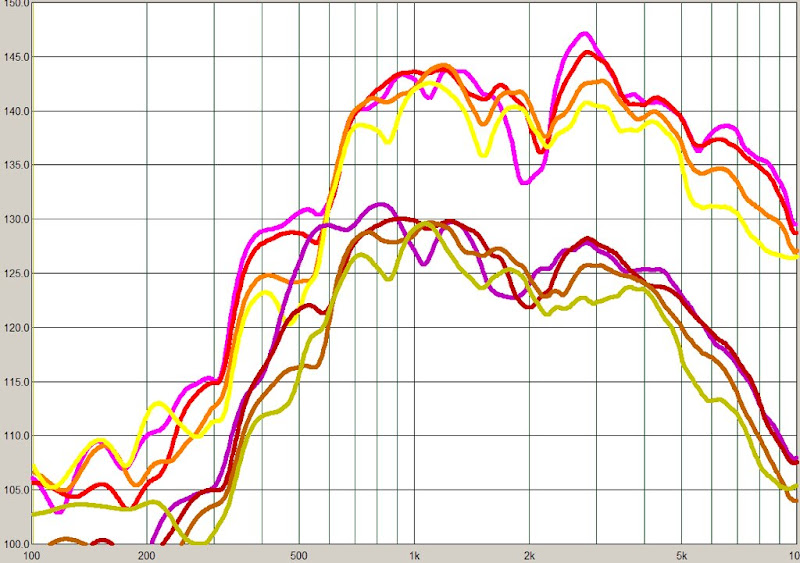
What do you think? Here are my thoughts:
- The 0 degree (purple) and the 15 degree (red) curve are virtually indistinguishable now. They track each other within 2db from 1200hz to 10khz. Remarkable for such a funky horn! And a dramatic improvement over the untreated horn.
- The untreated horn has a nasty dip and a peak at 1800hz and 2800hz, respectively. When you have a peak and a dip so close together, it's a challenge to treat with an EQ. But that didn't stop people from trying. These horns were used in dozens of "sound off" cars, where they were frequently paired with expensive Rane equalizers, modified for use in the car. The equalizers alone cost hundreds of dollars, and modding them for the car increases the cost. Now look at the treated horn. Where's the peak and the dip?
- The foam and the roundover has tamed the peak and the dip. Even better, what remains of the dip is fairly consistent on axis and off, and it's shallower and wider. This means that the dip can be treated with EQ (finally!)
- There's a dramatic reduction in the output level. It's down 3db at 1khz, but almost EIGHT db at eight khz. I think this is enlightening, because it illustrates that a significant percentage of the horn's output is being damped by the foam. I have stuffed an OS waveguide with foam, and measured it, and the reduction in SPL wasn't as dramatic as this. I believe this proves that the HOMster has more HOMs than an OS waveguide.
- The response curves of the treated horn fit in a tighter window. For example, the curves of the treated horn fit inside a window that's approximately five db wide. The response of the untreated horn fits inside a window that's eight db wide.
- Without a doubt, the most notable difference is that the treated response is consistent. The response of the untreated horn is consisten for about an octave, but then the off-axis response is subject to wild swings above 1500hz. Psychoacoustic research tells us that this is exactly where we DON'T want wild swings, since we're so sensitive to frequency response discrepancies above 1khz.
In summary, the objective measurements demonstrate that a small investement in PVC pipe and foam can reduce diffraction a great deal. And reducing diffraction improves the consistency of the on and off axis response. I am not able to measure HOMs, but I know what they sound like. In the next post, I'll describe the subjective improvement of these tweaks.
Last edited:
After finishing my tweaks, I gave the HOMster a listen. Here are my thoughts.
My first reaction was anger - I was literally pissed off that this horn could sound this good. The HOMster went from an ugly duckling to a swan in an hour. I was *infuriated*
I've been building horns for about a decade now, and I have a sizable collection of DIY designs. I've swapped out various compression drivers, dabbled in different curves, and obsessed for countless hours in front of Akabak and Hornresp.
And a stupid piece of PVC pipe and a handful of foam made all the difference in the world.
Seriously, I really wanted to set fire to all my other horns, the difference was THAT dramatic. While I have been building waveguides for a few years now, and using the foam religiously, I wasn't prepared for the improvement that they bestowed upon a lowly diffraction horn. If anyone reading this has a set of horns:
Run, don't walk to your nearest Home Depot. PVC pipe is your friend. And get a foam plug if you really want to be blown away.
It was particularly frustrating because I have a car depreciating in my driveway, and taking up a ton of space, which has tractrix horns driven by hard-to-find AlNiCo compression drivers. I invested months of work on those tractrix horns, and an hour of tweaks had trumped it. The only reason I still own the car is that it would take weeks to UNdo all the things I had to do to cram those giant AlNiCo compression drivers into the car. To give you an idea of their size, here's a pic.

HOMster on the left, a horn I made in 2002 to the right, giant AlNiCo tractrix horns, and an elliptical OS waveguide. The three on the right are DIY.
- The HOMster sounded like it had moved back about three or four inches. The sound no longer seemed to emanate from the mouth, it seemed to emanate from a point further back in space.
- If you look at the measurements, there's a dramatic reduction in SPL with the foam. The subjective impression that the sound is no longer coming from the mouth of the horn may be consistent with those measurements.
- Oddly enough, the speaker sounded "bigger". It was as if the source of the sound was nebulous, whereas before it was quite distinct. (this is in mono, btw.)
- One thing that I hate about horn loaded compression drivers is that they make you obsess over EQ. I am particularly compelled to cut the range from about 1500hz to 3000hz. The problem is that EQ won't fix this. After I apply "the cut" the sound of the horn is dark, but the "gritty" character of the horn remains. The roundover and the foam virtually eliminated the "grit." If you don't believe me, look at the measurements.
- I immediately felt compelled to sit down, relax, and play these VERY loudly. Years ago I ran these in my car, and found that I couldn't tolerate to play these loudly for very long. They were impressive in small doses, but I generally used them at a polite level. After treatment, the HOMster just begs you to flaunt it's dynamics.
- The HOMster is audibly smoother after treatment, though the top end is clearly rolled off. Perhaps the ear prefers a response that's flat and sloping over one that's ragged?
My first reaction was anger - I was literally pissed off that this horn could sound this good. The HOMster went from an ugly duckling to a swan in an hour. I was *infuriated*
I've been building horns for about a decade now, and I have a sizable collection of DIY designs. I've swapped out various compression drivers, dabbled in different curves, and obsessed for countless hours in front of Akabak and Hornresp.
And a stupid piece of PVC pipe and a handful of foam made all the difference in the world.
Seriously, I really wanted to set fire to all my other horns, the difference was THAT dramatic. While I have been building waveguides for a few years now, and using the foam religiously, I wasn't prepared for the improvement that they bestowed upon a lowly diffraction horn. If anyone reading this has a set of horns:
Run, don't walk to your nearest Home Depot. PVC pipe is your friend. And get a foam plug if you really want to be blown away.
It was particularly frustrating because I have a car depreciating in my driveway, and taking up a ton of space, which has tractrix horns driven by hard-to-find AlNiCo compression drivers. I invested months of work on those tractrix horns, and an hour of tweaks had trumped it. The only reason I still own the car is that it would take weeks to UNdo all the things I had to do to cram those giant AlNiCo compression drivers into the car. To give you an idea of their size, here's a pic.
HOMster on the left, a horn I made in 2002 to the right, giant AlNiCo tractrix horns, and an elliptical OS waveguide. The three on the right are DIY.
High Order Modes are supposedly linear *decay* artifacts (..that are more apparent at higher spl's).
The freq. plots (while interesting), don't necessarily display artifacts produced by "HOM"s. What they *do* show however is the degree of imposed "ripple" created by the primary diffraction signature of the horn "mouth" to baffle". In other words the entire bandwidth is being modulated by the change from a high pressure region to a low pressure region.
Now a Cumulative Spectral Decay plot (at varying levels), should display HOM's (if they exist).
The freq. plots (while interesting), don't necessarily display artifacts produced by "HOM"s. What they *do* show however is the degree of imposed "ripple" created by the primary diffraction signature of the horn "mouth" to baffle". In other words the entire bandwidth is being modulated by the change from a high pressure region to a low pressure region.
Now a Cumulative Spectral Decay plot (at varying levels), should display HOM's (if they exist).
Pretty much confirms what I have been saying all along. Some people still won't accept it however.
Excuse me, *what*?

I like the thread as well, but in precisely what way does it confirm what you have "been saying all along"?
IMO it's more along the lines of what Jean-Michel has been saying all along:
i.e. "TREAT THE MOUTH of the horn."
After all, in this thread there is still a "nasty" diffraction slot present at the throat here.
High Order Modes are supposedly linear *decay* artifacts (..that are more apparent at higher spl's).
The freq. plots (while interesting), don't necessarily display artifacts produced by "HOM"s. What they *do* show however is the degree of imposed "ripple" created by the primary diffraction signature of the horn "mouth" to baffle". In other words the entire bandwidth is being modulated by the change from a high pressure region to a low pressure region.
Now a Cumulative Spectral Decay plot (at varying levels), should display HOM's (if they exist).
Per their definition:
"Higher Order Mode, its a term that I coined to define waves that propagate in a waveguide that do not go down the axis, but travel by bouncing off of the walls. "
Having established that, note the following:
- The off axis response of the treated device is better than the off axis response of the untreated device. This reinforces the theory that a significant fraction of the energy produced by the untreated horn is being generated by waves which are not traveling down the axis of the horn.
- I have treated oblate spheroidal waveguides with foam, and they experience a modest reduction in SPL. About 3db above 10khz, decaying to about 1db at 1khz. This horn, with a diffraction slot, is seeing a much greater reduction in SPL, with a foam plug which is smaller. My theory is that there are more HOMs in this diffraction horn than in an OS waveguide, and the foam is attenuating them.
Good thread. I'd like to see the 'towel mod' quantified with some measurements. For a towel, you could substitute thick felt, absorbing foam (as opposed to the semi-transparent reticulated foam), etc.
I did some measurements with egg crate foam place below, to the left, and to the right of the horn's mouth. It didn't make a noticeable difference in the response.
My hypothesis is that that egg crate foam works on such a narrow band of frequencies that it's effect is barely noticeable.
If I had the room it would be great to try this with a MONSTER roundover, like 4" or even six inches.
With the horns the best tweaks seemed to be:
- reticulated foam in the horn
- the biggest roundover that you can live with... the bigger the better.
- even a small amount of vibration in the horn is re-radiated... braces and clay are your friend.
With the horns the best tweaks seemed to be:
- reticulated foam in the horn
- the biggest roundover that you can live with... the bigger the better.
- even a small amount of vibration in the horn is re-radiated... braces and clay are your friend.
Sure sounds familiar to me.
- Home
- Loudspeakers
- Multi-Way
- The HOMster! (or How I Learned How to Fix a Horn)
